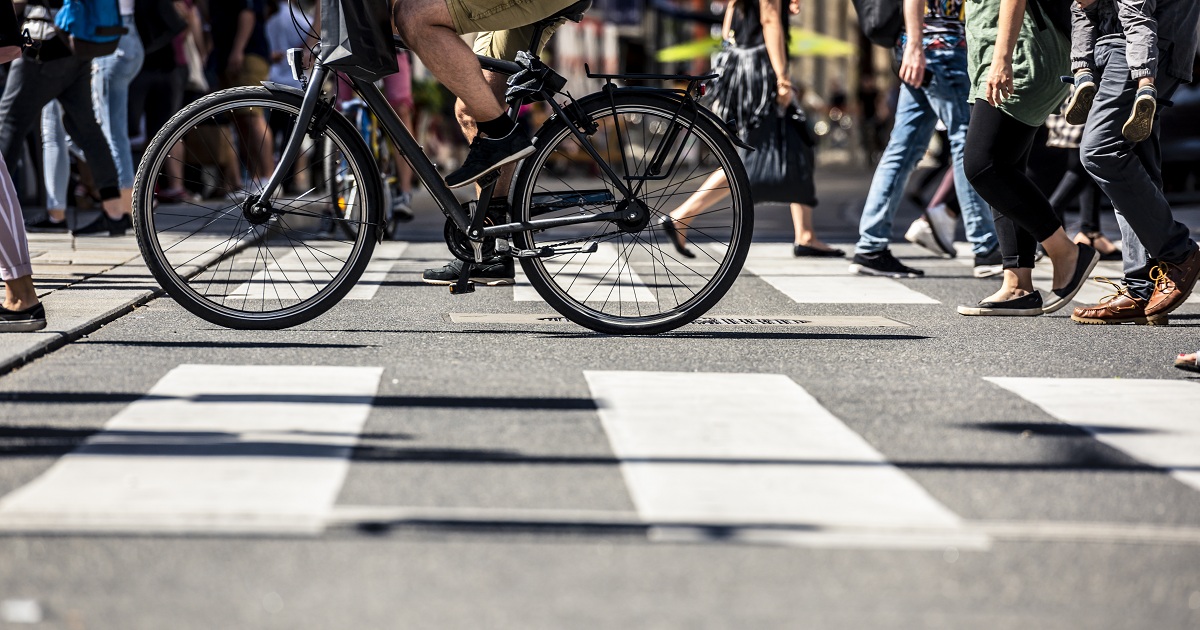
Article | May 26, 2021
Governments and public authorities, like any other part of society, are vulnerable to technological disruption. Many of the issues confronting the government today stem from the fight to combat the global COVID-19 pandemic. Government institutions frequently discover that by employing tactics and strategies similar to those used by industry and the private sector, they, too, could learn to be more flexible and agile in their response.
As a result, they have experienced a faster rate of digital transformation. Artificial intelligence (AI), the internet of things (IoT), and digital twins are now firmly on the agenda of governments and public bodies, whereas they were previously only on the roadmap. Many governments, particularly in more developed countries, have realized that they simply cannot afford to be complacent when there is so much potential for positive change.
So, with that in mind, here's a rundown of some of the most significant tech trends affecting governments in 2022.
Digital Identity:
Biometric measures, can be used in identity schemes to link an individual as a physical entity to their digital identity.
AI and Automation of Public Services:
In the United States, federal, state, and local governments are all ramping up experiments with natural language processing (NLP) technologies to reduce customer friction.
Cyber Security:
Close monitoring of cyber security is a high priority for states. In 2021, the US government announced that it would assist businesses in defending themselves against nation-state attacks.
National Cryptocurrencies:
The benefits of cryptocurrency as a monetary system are clearly compelling enough to pique the interest of governments and central banks, but there are questions that must be addressed, particularly those concerning environmental costs and energy consumption, which may have political ramifications.
The Rise of Govtech Start-ups:
The field is now open for a new breed of start-up known as "govtechs" to bring fresh thinking to the challenge of driving the digital revolution in government.
For example, in the United States, federal, state, and local governments are popular with services that received a high volume of calls during the pandemic. The above discussed trends are the five biggest tech trends transforming government in 2022.
Read More

Emerging Technology, Government Business
Article | October 7, 2022
Motorists and automobile lovers are already noticing rather rapid change. Sustainability goals adopted by elected officials at cities and counties are continuing to promote projects that support walking, biking, and using public transportation. Housing density, walkable communities, technology enhancement and convenient public transportation are the goals.
Parking options are being reduced. Automobiles are being banned on many community streets, and cities are adding parks, entertainment venues, affordable housing, and more retail. Mixed use development, biking lanes, and convenient transportation options for non-motorized travel are the goal. The arguments for such changes are that people will be healthier and safer, the air will be cleaner, and there will be more options for people with disabilities. The trend is called ‘livable and walkable communities,’ and as it sweeps through the country, it opens up thousands of partnering opportunities between public entities and private sector contractors.
Indiana
The city of Indianapolis plans to add more sidewalks throughout the city and has commissioned an inventory to determine how many and which streets don’t have a sidewalk. The results of that study will be published by the end of 2020. The city, which covers 360 square miles, has approximately 8,400 lane miles of streets. Indiana’s Department of Transportation maintains about one-third of the state’s sidewalks, and the cities are responsible for the rest. The study is part of the Indy Moves plan, a long-range planning document that combines walking, biking, and public transportation goals. More than 400 projects are outlined that include building new roads, developing greenways, upgrading existing roads with sidewalks, and constructing more bike lanes. Adding sidewalks to every street without them could cost more than $1 billion. The sidewalks, however, appear to be a high priority because city officials have pledged net zero carbon emissions by 2050 and that requires fewer automobiles in the city.
Texas
In August, the city of Houston approved a plan that is built around walkable places and transit-oriented programs that encourage pedestrian-friendly spaces. The city, like many others throughout the country, will work to promote mixed-use development designed for walkability. For three years, the city has studied ways to make neighborhoods more walkable. Its new plan lists Midtown, Emancipation Avenue, and the Northside as the first places of high focus. Ordinances will be effective beginning October 1. Some of the first initiatives include the construction of facades closer to the road, expansion of sidewalks and relocation of parking lots to the side or rear of buildings. Additionally, the ordinances call for additional bike parking standards in areas that are within a half-mile walking distance from Metro transit station platforms.
New Hampshire
The Southern New Hampshire Planning Commission recently unveiled its Transit-Oriented Development (TOD) Plan. The document outlines projects that include constructing streets and paths that encourage walking and biking. It calls for developing safer intersections and compact and well-signed city blocks. The city of Manchester has applied for a $25 million federal grant to will help fund a pedestrian bridge and the addition of a new street to help alleviate traffic congestion around the Southern New Hampshire University parking garage. City leaders hope to know by November if their grant request has been approved. If so, projects related to improving connectivity and walkability will be launched. The plan calls for an approximate $125 million investment, but the projects could unlock $600 million more in anticipated development. The new developments are expected to include a facility for 1,802 residential units, a hotel with 154 rooms, 785,000 square feet of office space, and 198,000 square feet of retail space.
Illinois
The city of Chicago has announced an initiative called INVEST South/West. This plan commits $750 million of public funds for projects in 12 commercial corridors in 10 neighborhoods. The objective of this plan is to improve streetscapes and public and also strengthening transportation networks and repurposing vacant lots for public amenities and affordable housing. Currently, three solicitation documents have been released for one neighborhood but numerous others will be released in coming months for projects in other neighborhoods. The initial solicitation documents call for proposals by November 24 with construction to begin by the end of 2020. Projects outlined for the various neighborhoods were developed through a months-long community-engagement process, and the developers and contractors will be expected to begin work quickly.
California
The city of Modesto has approved a 20-year plan that calls for bicycle lanes as well as widening and enhancing of sidewalks. Other projects are also planned with the overall objective of making neighborhoods more convenient for non-drivers and encouraging foot traffic and bicycles. City leaders point out that the downtown area has strong office, restaurant, and entertainment sectors, but there is a desire to reduce automobile traffic. Denser housing options and the encouragement of transportation options that include walking and biking are the goal. Construction of new home sites, retail, and other uses will be left to developers. City leaders plan to replace the Stanislaus County Courthouse and adjacent jail to make that property available for new, denser home sites. A pedestrian-friendly route would lead to the Tuolumne River.
Georgia
Clayton County and the cities of Sandy Springs, Savannah, and Valdosta were selected for funding in Georgia Tech's 2020 Georgia Smart Communities Challenge. Each region will receive $100,000 in grant funding to be used for planning purposes. The Clayton County Smart Pedestrian Planning project outlines plans to promote mobility, equity, and the identification of smart technologies to support walkability in communities. Sidewalk data will be collected, and the county will oversee the selection of pilot projects in locations that represent different neighborhood typologies. The first projects will be studied for future development of additional regions.
Cities and counties throughout the country are rushing to meet sustainability goals and these efforts are resulting in an abundance of contracting opportunities for developers, engineering firms, construction companies, landscape firms, and technology providers.
Mary Scott Nabers is president and CEO of Strategic Partnerships Inc., a business development company specializing in government contracting and procurement consulting throughout the U.S. Her recently released book, Inside the Infrastructure Revolution: A Roadmap for Building America, is a handbook for contractors, investors and the public at large seeking to explore how public-private partnerships or joint ventures can help finance their infrastructure projects.
Read More

Government Business, Government Finance
Article | July 12, 2022
Unless America and China assume joint leadership for global economic recovery, reconstruction of the post-coronavirus world could take years, with unimaginable consequences for the world’s 7.8 billion inhabitants, including unprecedented levels of global unemployment, famine, and even war.
In the pre-coronavirus world, suggestions for a partnership between the world’s two superpowers would have been met with gales of laughter. But now, despite the two leaders’ daggers drawn posture, hundreds of doctors and scientists in the U.S. and China are already working together on clinical trials of potential coronavirus drugs; and one of China’s biggest property developers has funded a five-year $115 million project between Harvard University and the Guangzhou Institute for Respiratory Health.
But the window of opportunity for acting together is short. The Covid-19 pandemic continues to decimate the world’s economies. Unemployment in the U.S. now tops 22 million, a level not seen since the great-depression of the nineteen-thirties; while China’s economy stopped growing for the first time in four decades as half a million small and mid-size businesses, the backbone of China’s economy closed; and Italy, the second largest manufacturing economy in the EU watches helplessly as the pandemic axe dismembers its economy. Were India and Africa were unable to control the coronavirus the results could be catastrophic.
So, are there issues of such import and mutual benefit that they would convince President’s Trump and Xi Jinping to work together? I believe there are. My two cents worth below.
The two superpowers could leverage China’s vast, trillion-dollar global infrastructure project—the Belt and Road Initiative or BRI, that aims to build infrastructure in over 120 countries of Asia, Europe, and Africa. The BRI is designed to act as a conveyer belt to transmit Chinese investment and technology into these countries to improve their economies, and to link them to China. But now Covid-19 has crimped China’s ability to sustain BRI’s trillion-dollar underwriting tab and President Xi Jinping’s grandiose vision is at risk.
On the other hand, the United States, which has been searching for a counter to BRI, has settled on an initiative called the Blue Dot Network or BDN. The idea behind the BDN is the U.S. would rigorously vet infrastructure project applications in developing countries to ensure high levels of transparency, sustainability, and economic viability before seeding them with startup funds from the U.S. Government. The BDN hallmark would then inspire confidence in the projects to attract private U.S. funding.
But the relatively paltry BDN budget of $60 billion (versus China’s 1000 billion or trillion-dollar BRI budget) and developing countries’ skepticism of Western (read U.S.) dominated standards for infrastructure construction have hobbled the BDN.
If the U.S. and China could find a way to combine BRI and the BDN it would ensure a stream of dollars from private U.S. companies into BRI and ensure its projects remain on track to create jobs and raise living standards around the world. The compromises required by America and China to weld BRI and BDN together would ensure the U.S. gets a seat at the table to influence the adoption of standards for starting and executing BRI projects.
Here’s another idea: The U.S. military is especially qualified to help fight natural disasters. In 2004, for instance, 3,000 U.S. military personnel were deployed to West Africa to help combat a deadly Ebola epidemic. Their work included constructing 17 hospitals, field training, and deploying assistance by air to remote villages. Today the U.S. military is being used to rapidly set up hospitals in U.S. cities to handle the burgeoning coronavirus caseload. The People’s Liberation Army meanwhile seems determined to play a more active global role in peace-keeping projects around the world.
Coronavirus-aid projects delivered to less-off countries through joint U.S.-China military teams would double what the U.S. and China could do on their own. And help establish the military to military connections that the U.S. has tried to foster with China for some time. A working relationship between the two nations’ militaries might even lead to a more stable geopolitical balance of power.
The Chinese word for crisis contains two characters. One signals danger, the other opportunity. Presidents Trump and Xi Jinping should boldly find a way to join forces to convert the deadly Covid-19 crisis into an opportunity that would supercharge global economic recovery and might well change the course of the 21st Century. It is a once in a lifetime opportunity that ought not to be squandered.
Read More

Article | July 15, 2020
As the country battles to recover from COVID-19, transit leaders are calling for the next federal relief package to appropriate substantial funding to allow public transit to play its critical part in the economy’s recovery.
In the interim, many of these transit and mobility authorities throughout the nation are moving forward with capital improvement projects already in the pipeline and in various phases of development. They will soon be announcing large projects, especially in quickly growing regions, and their planning documents list upcoming initiatives that range from mid-size construction projects to sprawling billion-dollar programs that focus on aging infrastructure.
The following are just a few examples of upcoming projects from tollway and mobility authorities.
California
Just east of San Francisco, the Tri-Valley-San Joaquin Valley Regional Rail Authority in late June approved $46.8 million in funding for the next stage in Valley Link, a 42-mile light-rail line. This project will connect a planned train station in North Lathrop to an existing station in Pleasanton. Another $13 million previously dedicated to the project paid for conceptual design work that is near completion.
Also, elsewhere in the state, the Transportation Corridor Agencies, in coordination with Caltrans, is proposing a $180 million project to add a direct 241/91 Express Connector linking the northbound 241 Toll Road to the eastbound 91 Express Lanes and the westbound 91 Express Lanes to the southbound 241 Toll Road. The connector will alleviate traffic and improve access to toll lanes in Orange and Riverside counties.
Texas
The Central Texas Regional Mobility Authority has several forthcoming procurements and will be soliciting bids in early August for the third phase of the 183A extension project. This $180 million project will create a 6.6-mile extension of the busy tollway north from Leander to east of Liberty Hill. Construction is expected to begin in early 2021.
New Jersey
The New Jersey Turnpike Authority has $24 billion in various road and infrastructure projects in its Proposed 2020 Capital Improvement Program released in March 2020. The authority has outlined 24 projects that provide system solutions and upgrades. One of the largest initiatives is a $2.9 billion project to replace approximately 200 bridge decks. Another large undertaking, projected to cost about $1.4 billion, is described as raising a section of Garden State Parkway above a revised 100-year floodplain.
Florida
Florida’s 2021 budget earmarks $90 million for an ambitious tollway project spanning hundreds of miles. The Multi-use Corridors of Regional Economic Significance, or M-CORES, plan calls for construction of 340 miles of new toll roads by 2030. M-CORES outlines new road infrastructure for three corridors: the Suncoast Connector from Citrus County to Jefferson County; the Northern Turnpike Connector from the northern terminus of Florida’s Turnpike northwest to the Suncoast Parkway; and the Southwest-Central Florida Connector from Collier County to Polk County. Initiated by a state Senate bill in 2019, this is a $10 billion project.
Kansas
The city of Overland Park and the Kansas Turnpike Authority are conducting a study that could lead to a $300 million project for U.S. 69. City leaders turned to the Turnpike Authority for help with widening the highway which has become the most congested in the state. The collaborative effort would include widening the highway to six lanes, with two of them being tolled.
Illinois
The Illinois Tollway Authority is closing its bid filing period for a more than $100 million project to reconstruct a section of Interstate 294, and numerous other projects are slated to occur in the next several years. A project to reconstruct the northbound C-D Road has a cost projection of between $25 and $50 million. Another planned project includes demolishing and rebuilding the Southbound Mile Long Bridge with a cost of more than $100 million. Another interesting project outlined involves building ongoing ramps from 75th Street to Interstate 55 which will also cost approximately$100 million.
Pennsylvania
The Pennsylvania Turnpike Commission (PTC) released a request for information to determine how best to structure procurements to replace and enhance the commission’s tolling Customer Service Center system and customer service operations. A number of contracting opportunities will result from this initiative. The commission is inviting responses from software application development companies with innovative products in the customer relationship management, customer account management, and customer experience spaces. System integrators and/or software developers with expertise in CRM, customer account management, call centers, customer contact systems and CX, and transactional/financial processing and billing systems also are also encouraged to respond. PTC is also interested in input from customer service firms specializing in the design and integration of innovative customer contact systems with new or existing applications.
In addition to construction and engineering projects, numerous tollway authorities are moving toward all-electronic toll collections. The Pennsylvania Turnpike Commission moved from toll collectors to all-electronic this year, and the Bay Area Toll Authority suspended in-person toll collecting in March because of COVID-19. This trend will provide numerous opportunities for IT companies in the near future as transit and mobility authorities search for technology solutions to modernize the driving experience on toll roads.
Mary Scott Nabers is president and CEO of Strategic Partnerships Inc., a business development company specializing in government contracting and procurement consulting throughout the U.S. Her recently released book, Inside the Infrastructure Revolution: A Roadmap for Building America, is a handbook for contractors, investors and the public at large seeking to explore how public-private partnerships or joint ventures can help finance their infrastructure projects.
Read More